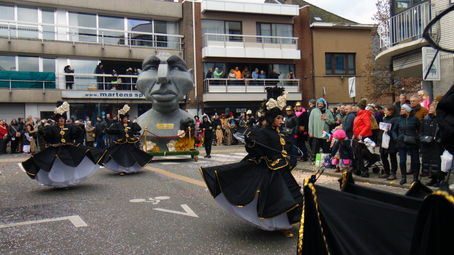
Carnival or Shrovetide is a Christian festive season that occurs before Lent, consisting of Quinquagesima or Shrove Sunday, Shrove Monday, and Shrove Tuesday or Mardi Gras.
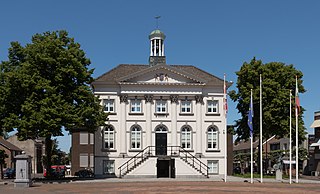
Zundert is a municipality and town in the south of the Netherlands bordering Belgium, in the province of North Brabant.

Aalst is a city and municipality on the Dender River, 31 kilometres (19 mi) northwest from Brussels in the Flemish province of East Flanders. The municipality comprises the city of Aalst itself and the villages of Baardegem, Erembodegem, Gijzegem, Herdersem, Hofstade, Meldert, Moorsel and Nieuwerkerken; it is the tenth largest city by population with 90.068 inhabitants. Aalst is crossed by the Molenbeek-Ter Erpenbeek in Aalst and Hofstade. The current mayor of Aalst is Christoph D'Haese, from the New-Flemish Alliance party. The town has a long-standing (folkloric) feud with Dendermonde, which dates from the Middle Ages.

Dendermonde is a city in the Flemish province of East Flanders in Belgium. The municipality comprises the city of Dendermonde and the towns of Appels, Baasrode, Grembergen, Mespelare, Oudegem, Schoonaarde, and Sint-Gillis-bij-Dendermonde. Dendermonde is at the mouth of the river Dender, where it flows into the Scheldt. The town has a long-standing folkloric feud with Aalst, south along the same river, which dates from the Middle Ages.

Binche is a city and municipality of Wallonia, in the province of Hainaut, Belgium. Since 1977, the municipality consists of Binche, Bray, Buvrinnes, Épinois, Leval-Trahegnies, Péronnes-lez-Binche, Ressaix, and Waudrez districts.

The Procession of the Holy Blood is a large religious Catholic procession, dating back to the Middle Ages, which takes place each Ascension Day in Bruges, Belgium. In 2009, it was included in the UNESCO Representative List of the Intangible Cultural Heritage of Humanity.
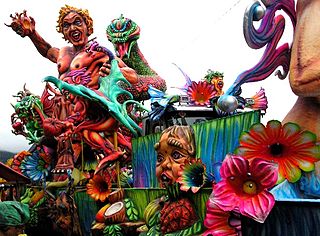
Blacks and Whites' Carnival, is a Carnival public festival and parade in southern Colombia established in 1546. Although its geographical location belongs to the city of Pasto, it has been adopted by other municipalities in Nariño and southwestern Colombia. It is celebrated every year in 2–7 January and attracts a considerable number of Colombian and foreign tourists.

The Barranquilla Carnival is one of Colombia's most important folkloric celebrations, and one of the biggest carnivals in the world. The carnival has traditions that date back to the 19th century. Four days before Lent, Barranquilla decks itself out to receive national and foreign tourists to join together with the city's inhabitants to enjoy four days of intense festivities. During the carnival, Barranquilla's normal activities are put aside as the city gets busy with street dances, musical and masquerade parades. The Carnival Of Barranquilla includes dances such as the Spanish paleo, African Congo, and indigenous mice y mica's. Many styles of Colombian music are also performed, most prominently cumbia, and instruments include drums and wind ensembles. The Carnival of Barranquilla was proclaimed a Cultural Masterpiece of the Nation by Colombia's National Congress in 2002. Also the UNESCO, in Paris on November 7, 2003, declared it one of the Masterpieces of the Oral and Intangible Heritage of Humanity, and it was during Olga Lucia Rodriquez Carnival Queen year.

The Carnival of Oruro is a religious and cultural festival in Oruro, Bolivia. It has been celebrated since the 18th century. Originally an indigenous festival, the celebration later was transformed to incorporate a Christian ritual around the Virgin of Candelaria . The carnival is one of UNESCO's Masterpieces of the Oral and Intangible Heritage of Humanity.
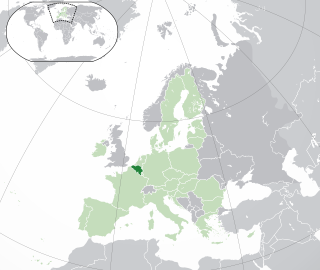
The history of the Jews in Belgium goes back to the 1st century CE until today. The Jewish community numbered 66,000 on the eve of the Second World War but after the war and The Holocaust, now is less than half that number.

The Carnival of Binche is an annual festival held in Binche, Hainaut, Belgium, during the Sunday, Monday, and Tuesday preceding Ash Wednesday.

Bloemencorso means "flower parade", "flower pageant" or "flower procession". In a parade of this kind the floats (praalwagens), cars and boats are magnificently decorated or covered in flowers. This custom goes back as far as the Middle Ages. Each parade has its own character, charm and theme. Many towns and regions in the Netherlands and Belgium hold parades every year.

Bloemencorso Zundert is the largest flower parade in the world. The parade takes place on the first Sunday of September, in Zundert, Netherlands. The floats are large artworks made of steel wire, cardboard, papier-mâché, and flowers. They are constructed entirely by volunteers. In the Bloemencorso Zundert, only dahlias are used to decorate the floats. Thousands often required to construct one and in total, around 8 million dahlias are needed for the Corso. Of these, around 6 million are cultivated in Zundert. The parade was founded in 1936.
The Folklore of Belgium is extremely diverse and reflects the rich legacy of cultural and religious influences which have acted on the region throughout its history, even before the establishment of the nation of Belgium in 1830. Much of Belgian folklore is unique to the region in which it is commemorated. Many aspects of folklore are manifested in public processions and parades in Belgian cities; traditions which are kept alive for the amusement of locals and tourists alike.
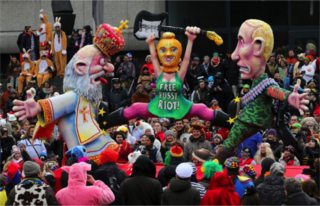
Carnival in the Netherlands is a festival held mainly in the Southern and Eastern regions of the Netherlands with an emphasis on role-reversal and the suspension of social norms, as part of celebrations of Carnival. The feast was assimilated by the Catholic Church, taking elements from ancient pagan spring festivals and is celebrated in the three days preceding the Christian holidays of Ash Wednesday and Lent.
Belgium is a European country with a Jewish population of approximately 35,000 out of a total population of about 11.4 million. It is among the countries experiencing an increase in both antisemitic attitudes and in physical attacks on Jews.
Events of the year 2020 in Belgium.

Christoph D'Haese is a Belgian politician and is affiliated to the N-VA.

The Grote Markt is the central square of Aalst, East Flanders, Belgium. The Aldermen's House, the Town Hall, the Beurs van Amsterdam, Herberg Graaf van Egmont and the Belfry/Schepenhuis are located there. The Grote Markt is an UNESCO buffer zone as well, thanks to the Schepenhuis.
Bastiaan Van Den Eynde is a Belgian basketball player for Basics Melsele of the Belgian Second Division. His cousin Niels Van den Eynde and brother Mathijs Van den Eynde are also professional basketball players.






